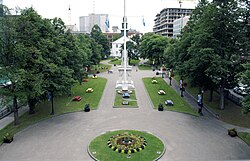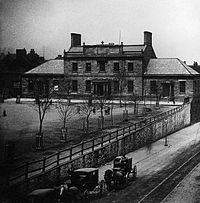
Halifax, officially known as the Halifax Regional Municipality (HRM), is the capital of the Canadian province of Nova Scotia. It had a population of 403,131 in 2016, with 316,701 in the urban area centred on Halifax Harbour. The regional municipality consists of four former municipalities that were amalgamated in 1996: Halifax, Dartmouth, Bedford, and Halifax County.

The North End of Halifax is a subdivision of Halifax, Nova Scotia occupying the northern part of Halifax Peninsula immediately north of Downtown Halifax. The area once included historic Africville, and parts of it were severely damaged in the Halifax Explosion during World War I. A neighbourhood with strong African Nova Scotian roots, more recently the area has undergone gentrification.

The Spring Garden Road area, along with Barrington Street is a major commercial and cultural district in Halifax, Nova Scotia, Canada. It acquired its name from the fresh water spring that flows directly beneath it. It comprises Spring Garden Road, South Park Street, and a number of smaller side streets. The area is considered to be one of the trendiest areas in Halifax and is one of the busiest shopping districts east of Montreal.
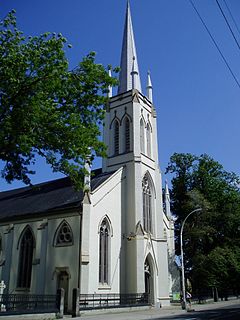
St. Matthew's United Church is a United Church of Canada church in downtown Halifax, Nova Scotia. The church was founded at the same time as the original colony in 1749 as a home for the various groups of dissenting Protestants who were from New England and who did not follow the Church of England. It originally met Sunday afternoons in St. Paul's Church, the Church of England building completed in 1750. The church got its own home in 1754 when a church was constructed at Hollis and Prince Streets. This building was destroyed by fire in 1857, and a new church was built at the current location at 1479 Barrington Street, land parcelled off of the Black-Binney House estate by Bishop Hibbert Binney. The church used the Old Burying Ground.

Fenwick Tower is a residential apartment building in the south end of Halifax, Nova Scotia, Canada. At 98 metres and 33 storeys in height, it is the tallest building in Atlantic Canada and the tallest building in Canada east of Quebec City.
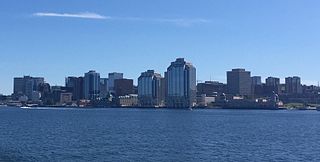
Downtown Halifax is the city centre of Halifax, Nova Scotia. Located on the eastern-central portion of the Halifax Peninsula, on Halifax Harbour, it serves as the business, entertainment, and tourism hub of the region.
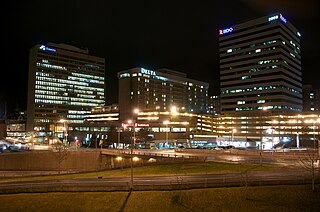
Scotia Square is a commercial development in Downtown Halifax, Nova Scotia, Canada. It was built in the late sixties to mid seventies and is managed by Crombie REIT. It is connected to the Downtown Halifax Link and serves as a major Halifax Transit bus terminal in Halifax.

The Downtown Halifax Link system is similar to Toronto's PATH or Montreal's RÉSO system, but on a much smaller scale. It consists of a network of climate-controlled pedways connecting various office buildings, hotels, parkades, and entertainment venues around downtown Halifax, Nova Scotia, Canada. These walkways are all open to the public, and are convenient during inclement weather and the winter months.

Hosting the region's largest urban population, Halifax, Nova Scotia is an important cultural centre in Atlantic Canada. Halifax is home to a vibrant arts and culture community that enjoys considerable support and participation from the general population. As the largest community and the administrative centre of the Atlantic region since its founding in 1749, Halifax has long-standing tradition of being a cultural generator. While provincial arts and culture policies have tended to distribute investment and support of the arts throughout the province, sometimes to the detriment of more populous Halifax, cultural production in the region is increasingly being recognized for its economic benefits, as well as its purely cultural aspects.
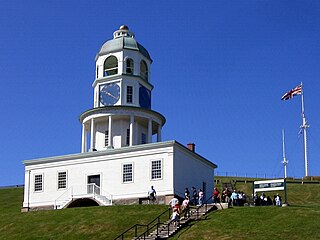
Halifax, Nova Scotia was originally inhabited by the Mi'kmaq. The first European settlers to arrive in the future Halifax region were French, in the early 1600s, establishing the colony of Acadia. The British settled Halifax in 1749, which sparked Father Le Loutre's War. To guard against Mi'kmaq, Acadian, and French attacks on the new Protestant settlements, British fortifications were erected in Halifax (1749), Bedford (1749), Dartmouth (1750), and Lawrencetown (1754). St. Margaret's Bay was first settled by French-speaking Foreign Protestants at French Village, Nova Scotia who migrated from Lunenburg, Nova Scotia during the American Revolution. All of these regions were amalgamated into the Halifax Regional Municipality (HRM) in 1996. While all of the regions of HRM developed separately over the last 250 years, their histories have also been intertwined.

St. Paul's Church is an evangelical Anglican church in downtown Halifax, Nova Scotia, within the Diocese of Nova Scotia and Prince Edward Island of the Anglican Church of Canada. It is located at the south end of the Grand Parade, an open square in downtown Halifax with Halifax City Hall at the northern end. Built during Father Le Loutre's War, it is the oldest surviving Protestant church in Canada and the oldest building in Halifax. There is also a crypt below the church. Close to the church is the St. Paul's Church Cemetery. The official chapel of the church was the Little Dutch (Deutsch) Church.

Barrington Street is a major street in Halifax, Nova Scotia, Canada, running from the MacKay bridge in the North End approximately seven kilometres south, through Downtown Halifax to Inglis Street in the South End. The civic numbers range from 950 to 4756 on the Halifax Peninsula street grid numbering system.

Halifax City Hall is the home of municipal government in Halifax, Nova Scotia, Canada. Designed by architect Edward Elliot and constructed for the City of Halifax between 1887 and 1890, it is one of the oldest and largest public buildings in Nova Scotia. The property was designated a National Historic Site of Canada in 1997.

Queen Elizabeth II Health Sciences Centre, in Halifax, Nova Scotia, Canada, is a large teaching hospital and Level 1 Trauma Centre affiliated with Dalhousie University. The QEII cares for adult patients. Pediatric patients within this region are cared for at the IWK Health Centre. Administratively, the QEII is part of the Nova Scotia Health Authority. The pipes in some parts of the QEII have been contaminated with legionella bacteria since the 1980s, which has rendered the building's water undrinkable.

This timeline of the History of the Halifax Regional Municipality documents all events that had happened in Halifax, Nova Scotia, Canada, including historical events in the former city of Dartmouth, the Town of Bedford and Halifax County. Events date back to the early-18th century and continue until the present in chronological order.

Burnley Allan "Rocky" Jones was an African-Nova Scotian and an internationally known political activist in the areas of human rights, race and poverty. He came to prominence first as a member of the Student Union for Peace Action (SUPA) during the 1960s and then as a civil rights activist, community organizer, educator, and lawyer.
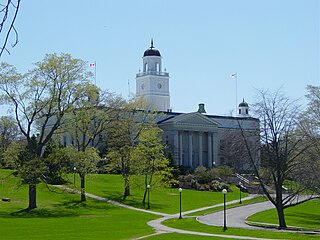
Leslie Raymond Fairn was a Canadian architect whose career is notable for its longevity and for the range of styles it encompassed, including Beaux Arts and Modernism. Most of his work was completed in the Maritimes.

The CBC Radio Building was a landmark Streamline Moderne-style office building located in Halifax, Nova Scotia overlooking the Halifax Citadel and Halifax Public Gardens which served as the home of CBC Radio in Nova Scotia from 1944 to 2014.
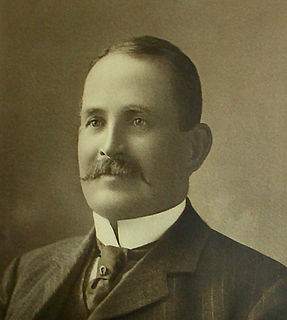
George Henry Wright was a significant business man and philanthropist in Halifax, Nova Scotia. He was born at Wright's Cove, Nova Scotia and died in the sinking of the Titanic at the age of 63. He established Write's World Business Directory in Boston and later returned to Halifax and invested in the city. His own house at 989 Young Ave, and two of his public buildings, the Marble Wright Building and The Saint Paul Building, still stand in downtown Halifax. They were all built by architect James Charles Philip Dumaresq.

Argyle Street is located in downtown Halifax, Nova Scotia, Canada. It is four city blocks and approximately 460 metres long. The street is a popular centre for live music, nightlife, theatre, and al fresco dining.
